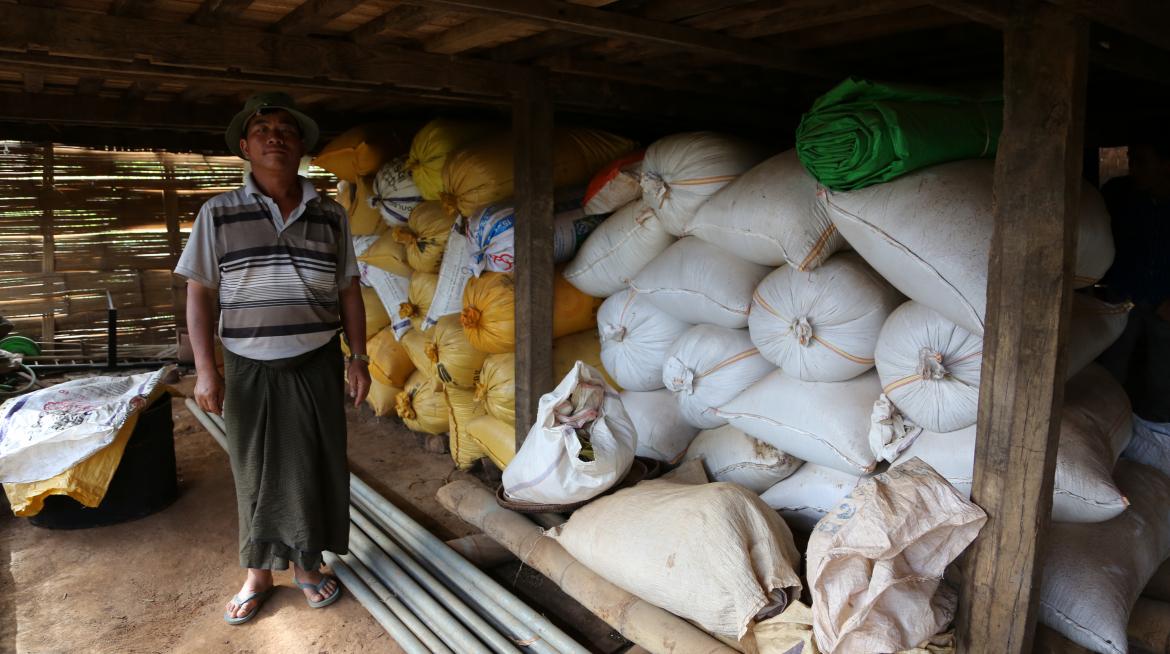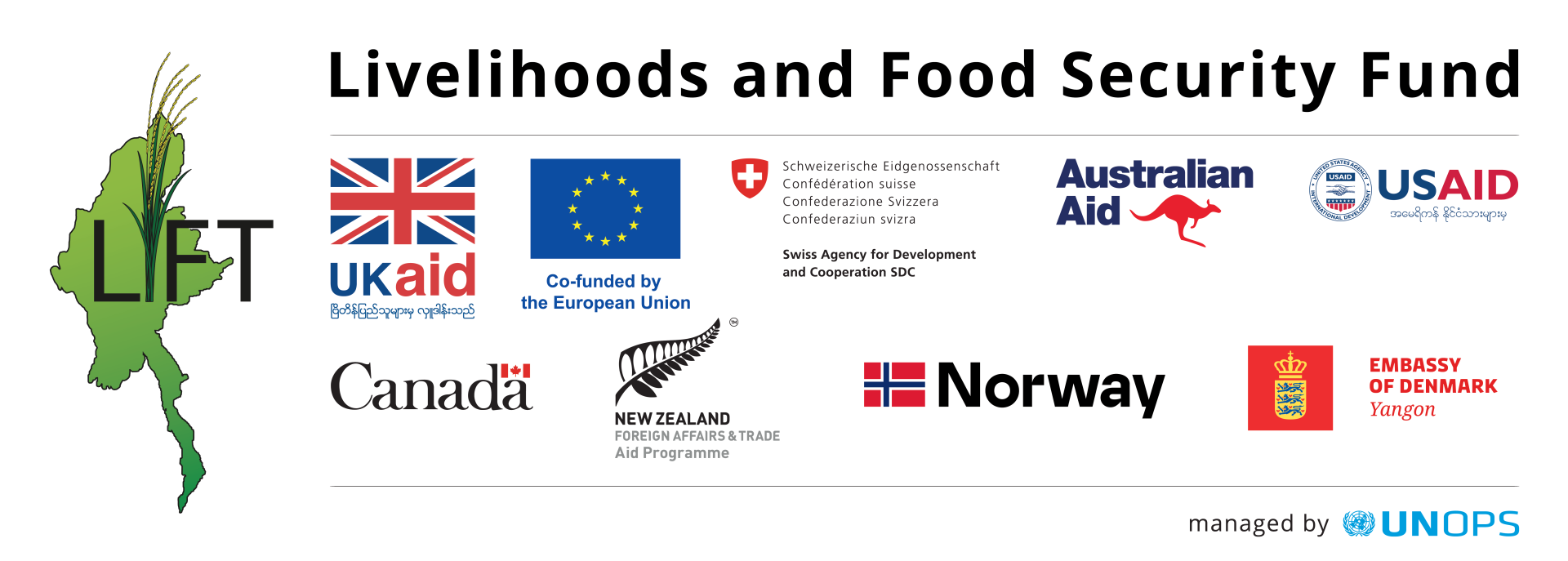
For best results, the design and operation of rice/seed banks should be moulded to local needs and conditions, says LIFT's Uplands Programme Officer, Antoine Deligne.
Rice/seed banks are an efficient social protection mechanism to improve access to rice or seeds, helping landless and small farmers to “hang in”, in accordance with LIFT's strategy. However, the system is often poorly adapted to the local situation and its needs.
Several LIFT implementing partners have supported rice banks as a food security tool in the Uplands, as in other regions.[1] The most typical approach is to set up a committee and provide an initial paddy stock purchased from local farmers at harvest time. The paddy is stored in a granary that is built with some contribution from the villagers. The paddy is distributed to the rice bank members during the lean season at a significantly lower interest rate than if they had to borrow from the market. The paddy is then reimbursed by the borrowers at the next harvest. This mechanism is said to reduce the burden that poor families face getting enough rice in the lean season, i.e. it is easier to access rice directly in the village at a significantly lower cost.
This simple mechanism has been effective in the Uplands where many households are not self-sufficient in rice production. But setting up a rice bank is not always successful and we have seen rice banks peter out after a project ends.
The following examples show different applications of the rice bank system, some more successful than others, and some that were subsequently changed by villagers to better align with their local context and needs.
To help analyse the needs it is useful to consider that the rice/seed bank has several interdependent mechanisms to facilitate (a) procurement/logistic arrangements, (b) storage, (c) access to finance, and (d) social protection/solidarity.
Rice banks including storage managed in-kind in Kachin State
During the last year of their project funded by LIFT, Metta has supported villages in Putao and Machanbaw Townships to set up rice banks as a social protection mechanism to assist poor households to access rice at reasonable cost during the lean season. However, some of the necessary operating features of the bank, e.g. where to procure paddy, whether or not storage is needed, or how members should reimburse, i.e. in kind or in cash, do not appear to be well understood. Some villages have a rice deficit and are isolated and others have a large surplus and/or easy access to markets. The need to ensure that rice bank applications are varied from village to village to match the different opportunities and constraints has not been taken into account - the same approach was being applied in all villages.
In some villages rice banks set up during an earlier UNDP programme are still functioning. They were transferred to the government with the financial management monitored by NaTaLa.[2] During a recent visit, villagers explained their difficulties for collecting reimbursements in kind with different varieties and often poor quality, due to most people reimbursing with their poorest paddy that then had to be sold to upgrade. Some beneficiaries had to purchase paddy from other villagers in order to reimburse their loan. The group committee was also reluctant to purchase paddy outside the village due to the logistics involved. However, procuring inside the village was not always easy especially if large scale farmers had already sold their rice to the brokers.
In some villages, the focus group said that the poorest villagers were unable to borrow from the rice banks, because they had no land and no paddy to harvest and to reimburse. They could not afford a one-time payment at harvest time. In most villages the local churches provided free rice loans to the poorest families.
Most of the rice bank groups in Banmaw Township of southern Kachin, in a similar programme managed by Banmaw LDO, supported by Swissaid and funded by LIFT, found that the rice bank is not well suited to casual labourers. It is difficult for them to store and mill paddy. They prefer to regularly procure small quantities of rice at the market and to reimburse in small instalments when income from labour is available. Getting to the regular meetings to set up and manage a rice bank is difficult for casual labourers who are necessarily mobile looking for job opportunities.
Group members are therefore mostly small lowland rice farmers who are selling paddy to millers. Some of these small farmers are heavily indebted and so the rice bank has proved useful in the lean season to avoid “green selling” of their crop (pre-selling the rice harvest) to meet consumption needs. Better-off members did not need to borrow but were interested to participate and contribute to the bank as they saw it as a useful social protection mechanism in the village. This led to the rice bank collecting rice from its members to distribute freely to the poorest villagers (elders, women headed households). Some non-rice bank members were also contributing for that purpose.
The rice bank also had an excess of reimbursed paddy each year and so was able to sell some and establish a revolving fund. Borrowing cash at 2.5 per cent per month is more attractive than the rice bank rate for borrowing paddy (30 to 50 per cent interest in-kind per season). This high rate for in-kind borrowing is necessary as the rice must be stored and a loss is incurred by distributing the rice when prices are high (lean season) and reimbursed when at their lowest at harvest time.
Collective procurement of rice in Chin State
Many Chin villages that we have visited with teams from our partner, Gret-CORAD also have rice bank systems that were set up successfully by UNDP under earlier non-LIFT projects. Most of these rice banks were playing an important role in the village economy, not only for the poor, but for all villagers. There, the system does not require storage. It is a collective procurement system where the villagers pool their resources to purchase milled rice in the nearby town or from the valley. The purpose is not so much social protection – local corn is a cheaper staple option for very poor families - but a means to manage the large rice deficit typical of the region. Traveling individually to the township market is costly and so collective buying allows for savings – and at a more competitive price. All transactions are managed in cash and so losses from quality and storage are avoided.
Seed banks in Northern Shan
A LIFT project managed by Cesvi in Northern Shan supported farmers to establish seed banks for rice, groundnut, wheat, soya, niger (guizotia abyssinica) and pigeon pea. Seventy seed banks were successfully established and managed by the village development committees. Many have been partially or completely transformed into cash revolving funds. In some banks, only a limited number of farmers needed the seed and so the stock on hand grew, allowing some seed to be sold for cash. Most farmers were able to store seeds themselves, but found the rice bank useful for renewing their seed to avoid degeneration over time. This meant it became important for the seed bank to regularly procure seed from a reliable external seed source rather than through the farmer in-kind reimbursement.
Despite the apparent success of these seed banks, members in many villages pressured their banks to shift to a cash system as their priority was for loans to purchase the expensive maize hybrid seeds which have become their main cash crop. Hybrid seed cannot be stored from one year to the next making the seed bank mechanism used in this context less interesting.
------
The different rice bank applications described above emphasise the importance of a flexible approach towards rice/seed bank operation to ensure that the different needs and objectives of different circumstances are to be met.
Solutions must be carefully explored during the diagnostic phase with consideration to the following:
- What is the target population, its main activity, source of income? Are they farmers or labourers?
- Is the village priority to access seeds, paddy, milled rice or cash loans?
- Is the village in a rice deficit or surplus area?
- How do villagers access markets and milling services?
- What are their storage practices?
- What is the local seasonal rice price variation?
- What are the easiest reimbursement modalities: in kind at harvest or in cash in small instalments?
- What is the cost of managing the system? How to avoid unnecessary transaction costs?
- What are the existing solidarity mechanisms? How can the rice bank support them rather than duplicate?
Storage may be useful to keep seeds or to benefit from the seasonal price variation. Procurement may be useful to source better quality seeds or provide for collective buying in a rice deficit area. The financial mechanism may be adapted to the needs of small indebted farmers or those of casual labourers who face different constraints; though it is rare that a single mechanism will suit both.
- If the system is set up in a rice deficit area it is important to procure paddy from outside the village to increase the overall rice availability.
- If paddy is procured from within the village, the access to paddy is not improved, or to a limited number of beneficiaries only.
- If the bank is in a surplus area and farmers already have sufficient storage capacity, then investment in storage operations will add little value and impose unnecessary cost and management.
- If storage is a problem, farmers increasing their own storage capacity may be better than developing collective systems.
- If farmers opt for a collective system and the purpose is to add value to their production, the system should be based on strict rules for quality control, price monitoring and marketing. Then, good financial procedures similar to those for cooperatives are necessary rather than the loose rules used by most community rice banks.
- Villages close to a market or a mill may find it less costly and easier to purchase small rice quantities rather than paddy that requires storage and milling in small quantities. Often cash loans will be less expensive and more flexible to the needs of the poorest and casual labourers.
- Revolving funds or Village Savings and Loans Associations are easier to manage, noting that rice banks are frequently transformed into cash systems as the members try to avoid the complexities of in-kind reimbursements.
We have rarely met a village where the rice or the seed bank was unsuccessful in meeting some villager needs. In many places, however, the system was poorly designed and had to be subsequently transformed by the villagers to better align to their needs. This is not necessarily a bad thing, as it shows the strength of the rice bank approach in its cultivation of village ownership and self-responsibility to ensure it works according to what makes sense in a given location. However, many projects are insufficiently equipped to analyse the local situation, discuss farmer preference and tailor the design of a system accordingly. More focus should be placed on the diagnosis phase, and the consideration of a range of options rather than a single blue-print system.


